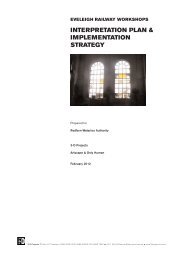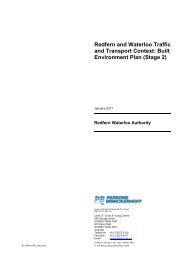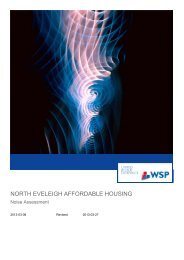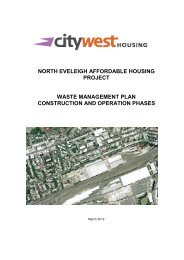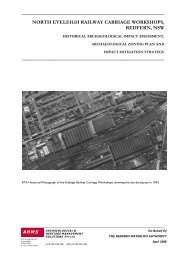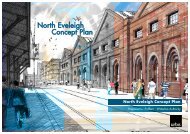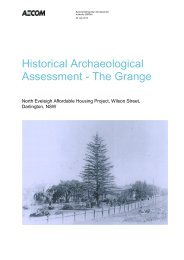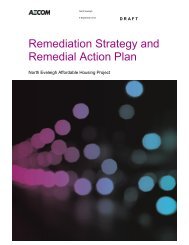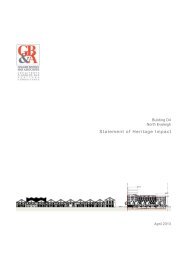here - SMDA - NSW Government
here - SMDA - NSW Government
here - SMDA - NSW Government
You also want an ePaper? Increase the reach of your titles
YUMPU automatically turns print PDFs into web optimized ePapers that Google loves.
(g) Accounting for the Goods and<br />
Services Tax (GST)<br />
Income, expenses and assets are<br />
recognised net of the amount of GST,<br />
except that:<br />
––<br />
the amount of GST incurred by the<br />
Authority as a purchaser that is not<br />
recoverable from the Australian<br />
Taxation Office is recognised as part<br />
of the cost of acquisition of an asset<br />
or as part of an item of expense; and<br />
––<br />
receivables and payables are stated<br />
with the amount of GST included.<br />
Cash flows are included in the Statement<br />
of Cash Flow on a gross basis. However,<br />
the GST components of cash flows<br />
arising from investing and financing<br />
activities which is recoverable from, or<br />
payable to, the Australian Taxation Office<br />
are classified as operating cash flows.<br />
(h) Income tax<br />
The Authority is a not for profit entity and<br />
is not a listed entity in the National Tax<br />
Equivalent Regime Entity Register.<br />
Hence it is not liable for income tax under<br />
the National Tax Equivalent Regime.<br />
On 16 February 2005, a private ruling<br />
was made in favour of ATPSL, w<strong>here</strong><br />
it was deemed that Section 24AM of<br />
Income Tax Assessment Act 1936 applies<br />
to exempt ATPSL’s income from the<br />
imposition of income tax. The ruling<br />
has been reconfirmed since 2005, with<br />
a further extension to 30 June 2015<br />
approved by the Australian Tax Office in a<br />
private ruling advice dated 29 June 2011.<br />
(i) Income recognition<br />
Income is measured at the fair value<br />
of the consideration or contribution<br />
received or receivable. Amounts<br />
disclosed as income are net of returns,<br />
trade allowances, rebates and amounts<br />
collected on behalf of third parties.<br />
Additional comments regarding the<br />
accounting policies for the recognition of<br />
income is discussed below.<br />
(i) Sale of goods and services<br />
Revenue from the sale of goods is<br />
recognised when the Authority transfers<br />
the significant risks and rewards of<br />
ownership of the assets and obtains<br />
control of the assets that result from sales.<br />
(ii) Rendering of services<br />
Revenue from the sale of goods is<br />
recognised as revenue when the entity<br />
transfers the significant risks and rewards<br />
of ownership of the assets.<br />
(iii) Grants and contributions<br />
An unconditional contribution and grants<br />
received are recognised as income<br />
when the Authority obtains control over<br />
the assets comprising the contribution.<br />
Control over contributions is normally<br />
obtained upon the receipt of cash.<br />
W<strong>here</strong> any unspent contributions at<br />
period end are repayable to the funding<br />
bodies in the following financial period,<br />
the unspent contributions are accounted<br />
for as liabilities rather than income.<br />
(iv) Lease income<br />
Rental revenue from operating leases is<br />
recognised in accordance with AASB 117<br />
Leases on straight-line basis over the<br />
lease term. The lease payments received<br />
in advance are recorded as a liability and<br />
recognised as income over the lease term.<br />
Lease incentives granted are recognised<br />
as an integral part of the total rental<br />
income, over the term of the lease. W<strong>here</strong><br />
the future rental income is at the discretion<br />
of the lessor (the Authority), the straight<br />
line income recognition is calculated<br />
assuming a future rental income of 5% of<br />
the market value of the relevant land.<br />
(v) Investment revenue<br />
Investment revenue comprises interest<br />
income on funds invested with financial<br />
institutions. In addition, any changes<br />
in fair value of financial assets held<br />
with the <strong>NSW</strong> Treasury Corporation’s<br />
Hour-Glass facilities represented by<br />
a number of units of a management<br />
investment pool at fair value through<br />
profit and loss account are recognised<br />
using the effective interest method as set<br />
out in AASB 139 Financial Instruments:<br />
Recognition and Measurement.<br />
(vi) Other income<br />
Other income is recognised when<br />
the right to receive the income has<br />
been established.<br />
(j) Assets<br />
(i) Acquisition of assets<br />
The cost method of accounting is<br />
used for the initial recording of all<br />
acquisitions of assts controlled by the<br />
entity. Cost is the amount of cash or<br />
cash equivalents paid or the fair value of<br />
the other consideration given to acquire<br />
the asset at the time of its acquisition or<br />
construction or, w<strong>here</strong> applicable, the<br />
amount attributed to that asset when<br />
initially recognised in accordance with<br />
the requirements of other Australian<br />
Accounting Standards.<br />
Assets acquired at no cost, or for nominal<br />
consideration, are initially recognised at<br />
their fair value at the date of acquisition.<br />
(refer also to assets transferred as a<br />
result of an equity transfer – Note 1 (l)).<br />
Fair value is the amount for which an<br />
asset could be exchanged between<br />
knowledgeable, willing parties in an arm’s<br />
length transaction.<br />
W<strong>here</strong> payment for an asset is deferred<br />
beyond normal credit terms, its cost is<br />
the cash price equivalents, i.e. deferred<br />
payment amounts are effectively<br />
discounted at an asset-specific rate.<br />
(ii) Capitalisation thresholds<br />
The Authority’s policy is to capitalise all<br />
costs incurred in property development.<br />
Property, plant and equipment and<br />
intangible assets costing $5,000 and<br />
above, individually or forming part<br />
of a network costing more than $5,000,<br />
are capitalised.<br />
2011-12 ANNUAL REPORT<br />
25



